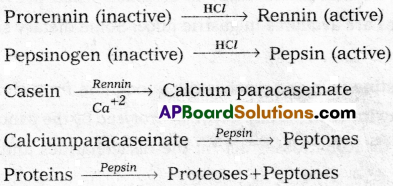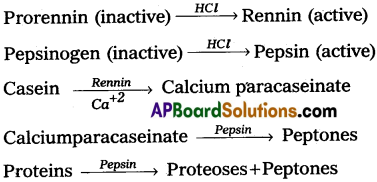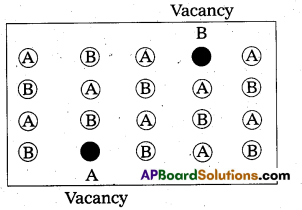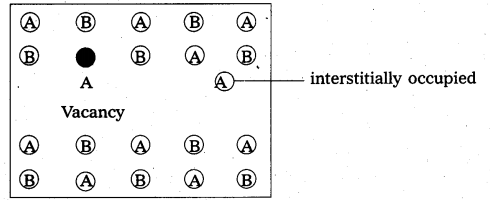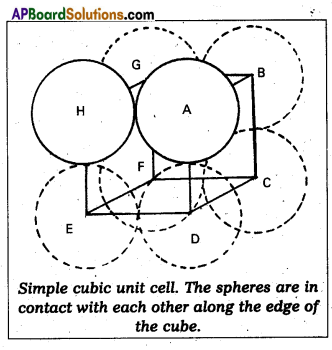Andhra Pradesh BIEAP AP Inter 1st Year Sanskrit Study Material पद्यभागः 1st Poem दशरथस्य पश्चात्तापः Textbook Questions and Answers, Summary.
AP Inter 1st Year Sanskrit Study Material 1st Poem दशरथस्य पश्चात्तापः
निबन्ध प्रश्नः Essay Questions
प्रश्न 1.
दशरयस्य दुःखं स्वयंकृतमासीत्?
How was the sorrow of Dasaratha self-created?
प्रश्न 2.
दशरयस्य पश्चत्तापः इति पाठस्य सारांशं लिखत|
Summarize the lesson दशरथस्य पश्चात्तापः
Answer:
Introduction :
The lesson दशरथस्य पश्चात्तापः is an extract from the Ayodhya Kanda of Ramayana, written by Sage Valmiki. Rama went to the forest at the command of Kaikeyi. Dasaratha could not bear separation from Rama. Then he told Kausalya that he was cursed by a sage during his youth.
Dasaratha’s Lamentation :
Dasaratha told Kausalya that one would receive the good or bad fruits of one’s own deeds only. Dasaratha committed a sin during his youth. He was famous for his ability to shoot at sound. He received the fruit of his action just as a boy who had eaten poison out of ignorance.
Going for hunting at night :
Once, when it was rainy season, Dasaratha went to the bank of river Sarayu at night for hunting. There, he heard the sound of a pitcher being filled with water. He mistook it for the sound made by an elephant and released an arrow towards that sound. अचश्रुविषये घोषं वारणस्येव नर्दतः|
The painful human cry:
Then he heard a human voice crying how anyone could hit a hermit, who came to the river to carry water. He grieved for his old parents. It was a cruel stupid, who killed all of them.
Dasaratha found a boy :
Dasaratha rushed to the bank of the river to find a hermit hit by his arrow. His hair was scattered, and the water pitcher fell at a distance. The boy asked the king what harm he did to him. He was about to carry water to his parents. Dasaratha killed his parents also who were weak and blind. He asked Dasaratha to carry the news to his father. पितुस्त्वमेव मे गत्वा शीघ्रमाचक्ष्व राघव ।
The old and blind couple :
“Carrying the water pot, Dasaratha went to the hermitage and saw the weak and blind parents of the boy who were without any support, and who looked like birds with clipped wings. The old man thought that it was his son, and asked him to give him some water. Then Dasaratha said that he was not their son, and he was Dasaratha, a Kshatriya. He told them that he went at night to the bank of the river Sarayu to kill, any wild animal or an elephant that came to drink water. He mistook the sound of filling a pitcher with water for that of an elephant, and killed it with an arrow. falsafah मत्वाऽयं बाणेनाभिहतो मया | But he saw their son with the arrow struck in the heart.
The curse uttered by the old man :
On hearing those cruel words, the sage could not control his emotion. He cursed Dasaratha saying that he would die lamenting for his son. To so garnicha Purahisi kurti
लघुसमाधानप्रश्नाः Short Answer Questions
प्रश्न 1.
कः बालः इति उच्यते?
उत्तर:
कर्मणाम् आरम्भसमये फलानां गुरुलाघवं वा दोषं वा न जानाति सः बालः इति उच्यते।
प्रश्न 2.
प्रस्तुतपाठ्यांशः कस्मात् उद्धृतः?
उत्तर:
प्रस्तुतपाठ्यांशः वाल्मीकिरामायणे अयेध्याकाण्डात् स्वीकृतः।

प्रश्न 3.
सरयूनदीतीरे दशरथः कम् अपश्यत्?
उत्तर:
सरयूनदीतीरे दशरथः इषुणा हतं तापसम् अपश्यत्।
प्रश्न 4.
मुनिः दशरथं किमिति शशाप?
उत्तर:
मुनिः दशरथं राजन्, पुत्रशोकेन त्वं कालं करिष्यसि इति शशाप।
एकपदसमाधानप्रश्नाः One Word Answer Questions
प्रश्न 1.
अयोध्यानगरस्य राजा कः?
उत्तर:
अयोध्यानगरस्य राजा दशरथः।
प्रश्न 2.
दशरथः कां नदीम् अन्वगात्?
उत्तर:
दशरथः सरयूनदीम् अन्वगात्।
प्रश्न 3.
घटमादाय दशरथः कुत्र जगाम?
उत्तर:
घटमादाय दशरथः आश्रमं जगाम |
प्रश्न 4.
दशरथः कि मत्वा बाणं प्रयुयोज?
उत्तर:
दशरथः गजं मत्वा बाणं प्रयुयोज |
सन्दर्भवाक्यानि Annotations
1. अचक्षुर्विषये घोषं वारणस्येव नर्दतः।
परिचयः –
एतत् वाक्यं दशरथस्य पश्चात्तापः इति पाठ्यभागात् सवीकृतम्। अयं पाठ्यभागः वाल्मीकिरामायणे अयोद्याकाण्डतः स्वीकृतः।
सन्दर्भः –
दशरथः कौसल्यां प्रति मुनिशापवृत्तान्तम् कथयन् एवम् उक्तवान्।
भावः –
अदृष्टिगोचरे रात्रौ गजस्य शब्दः इव श्रुतः।
विवरणम् –
दशरथः कौसल्याम् उक्तवान् यत् सः एकदा रात्रौ मृगयार्थं सरयूतीरं गतवान्। तत्र रात्री जलेन पूर्यमाणस्य कुम्भस्य शब्दः गजस्य शब्दः इव श्रुतः।।
2. पितुस्त्वमेव मे गत्वा शीघ्रमाचक्ष्व राघव।
परिचयः –
एतत् वाक्यं दशरथस्य पश्चात्तापः इति पाठ्यभागात् स्वीकृतम् | अयं पाठ्यभाग: वाल्मीकिरामायणे अयोध्याकाण्डतः स्वीकृतः।
सन्दर्भः –
तापसकुमारः दशरथम् एवम् उक्तवान्।
भावः –
राजन्, भवान् एव शीघ्रं गत्वा मम पितरम् एनम् कृतान्तम् वदतु ।
विवरणम् –
मृगयार्थं गतः दशरथः गजः इति मत्वा रात्री बाणेन तापसं हतवान् | नदीतीरे पतितः तापसः दशरथम् उवाच यत् भवान् मम पितरं मम मरणवार्ता वदतु इति ।
3. द्विपोऽयमिति मत्वाऽयं बाणेनाभिहतो मया ।
परिचयः –
एतत् वाक्यं दशरथस्य पश्चात्तापः इति पाठ्यभागात् स्वीकृतम् । अयं पाठ्यभागः वाल्मीकिरामायणे अयोध्याकाण्डतः स्वीकृतः ।
सन्दर्भः –
दशरथः तापसस्य वृद्धं पितरम् एवम् उक्तवान् ।
भाव –
अहं गजः इति मत्वा भवतः सुतं बाणेन हतवान् ।
विवरणम् –
दशरथः तापसस्य वृद्धं पितरम् उक्तवान् यत् सः कुम्भपूरणशब्दं श्रुत्वा अज्ञानतः गजः इति मत्वा तापसं बाणेन हतवान् इति ।

4. एवं त्वं पुत्रसोकेनतत राजन् कालं करिष्यसि ।
परिचयः –
एतत् वाक्यं दशरथस्य पश्चात्तापः इति पाट्यभागात् स्वीकृतम् । अयं पाठ्यभागः वाल्मीकिरामायणे अयोध्याकाण्डतः स्वीकृतः ।
सन्दर्भः –
तापसस्य वृद्धः पिता दशरथम् एवं शशाप |
भावः –
राजन्, भवान् अपि पुत्रवियोगेन मरिष्यति ।
विवरणम् –
दशरथः तापसस्य वृद्धं पितरम् अज्ञानतः आत्मना कृतं पापम् उक्तवान् | पुत्रस्य मरणं श्रुत्वा शोकमग्नः वृद्धः दशरथं शशाप – भवान् अपि पुत्रशोकेन मरिष्यति इति ।
विशेषतो ज्ञेयाः
कठिनशब्दार्थाः
चापः – बाणः।
वारणस्य – गजस्य।
वासंसः: वस्रस्य।
आचक्ष्व – वद।
द्विपः – गजः।
निहतः – मारितः।
द्विजौ पक्षिणौ ।
व्याकरणांशाः Grammar
सन्धयः अथ + अन्धकारम् = अथान्धकारम् – सवर्णदीर्घसन्धिः
विष + उपमम् = विषोपमम् – गुणसन्धिः
जराभारधरस्य + एव = जराभारधरस्यैव – वृद्धिसन्धिः
मर्मणि + अभिहतः = मर्मण्यभिहतः – यणादेशसन्धिः
बाणेन + अभिहतः = बाणेनाभिहतः – सवर्णदीर्घसन्धिः
द्वौ + अन्धौ = द्वावन्धौ – अयवायावसन्धिः
समासाः।
कामविवर्धिनी – कामस्य विवर्धिनी – षष्ठीतत्पुरुष समासः
व्यथितमर्मणः – व्यथितं मर्म यस्य तस्य – बहुव्रीहि समासः
अकृतात्मा – अकृतः आत्मा येन सः – बहुव्रीहि समासः
परमवारि – परमं च तत् वारि च – विशेषणपूर्वपद कर्मधारय समासः
लूनपक्षः – लूनौ पक्षौ यस्य सः – बहुव्रीहि समासः
शोककर्शितः – शोकेन कर्शितः – तृतीयातत्पुरुष समासः
गतप्राणः – गताः प्राणाः यस्य सः – बहुव्रीहि समासः
कृताञ्जलिः – कृतः अञ्जलिः येन सः – वहुव्रीहि समासः
दशरथस्य पश्चात्तापः Poem Summary in English
दशरथस्य पश्चात्तापः Poem Introduction:
Valmiki is praised as Adikavi, the First Poet. Ramayana, which was written by him, is considered as the Adikavyam, the First Poem. There are seven kandas (books) in it. Rama’s story was described in it. It is said that Rama was Vishnu Himself, and Ramayana was the Veda itself. Many virtues which are to be practiced such as the love between husband and wife, the affection of the brothers, devotion towards the. teacher, obeying the word of the father, friendship, protecting the refugees, following dharma, ruling the people amicably, etc. were well established in this work. Hence it was said :

यावत्स्थास्यन्ति गिरयः सरितश्च महीतले |
तावद्रामायणकथा लोकेषु प्रचरिष्यति ||
As long as the mountains and the rivers remain on the earth, so long will the Ramayana spread in the worlds.
The present lesson is an extract from the 63rd and 64th cantos of the Ayodhyakanda in the Ramayana. Here the story of a young hermit’s cursing of Dasaratha leading to his death due to separation from his son has been described. Rama went to the forest because of the boon given to Kaikeyi by Dasaratha. The king who was saddened at the separation from his son then told this story to Kausalya.
दशरथस्य पश्चात्तापः Poem Summary
Dasaratha’s Lamentation :
‘Dasaratha told Kausalya about the curse he received from an old sage. One will receive the good or bad fruits of his own deeds only. He is a stupid who does not consider the good or bad consequences right at the start of an action. Dasaratha committed a sin during his youth. He was famous for his ability to shoot at sound even at such a young age. He received the fruit of his action just as a boy who had eaten poison out of ignorance.
Going for hunting at night :
Dasaratha was not married at that time. Once, when it was rainy season, he went to the bank of river Sarayu at night for hunting. There, at night he heard the sound of a pitcher being filled with water. He mistook it for the sound made by an elephant and released an arrow towards that sound.
The painful human cry:
Then a human voice was heard distinctly crying “Alas ! How can an arrow be shot at me, a hermit. I came to the river to carry water. I am one with matted locks wearing bark and deer skin. I grieve for my old parents. Who is that cruel one who killed all of us ?”
Dasaratha found a boy :
Dasaratha rushed to the bank of the river to find a hermit hit by his arrow. His hair was scattered, and the water pitcher fell at a distance. The boy asked the king what harm he did to him. As he was about to carry water to his parents he was killed. Dasaratha killed his parents also who were weak and blind. They were waiting for their son. He asked Dasaratha to carry the news to his father.
The old and blind couple :
Carrying the water pot, Dasaratha went to the hermitage taking the path mentioned by the boy. There he saw the weak and blind parents of the boy who were without any support, and who looked like birds with clipped wings. On hearing the footsteps of Dasaratha, the old man thought that it was his son, and asked him to give him some water. Then Dasaratha said that he was not their son, and he was Dasaratha, a Kshatriya. He told them that he went at night to the bank of the river Sarayu to kill any wild animal or an elephant that came to drink water. He mistook the sound of filling a pitcher with water for that of an elephant, and killed it with an arrow. But he saw their son with the arrow struck in the heart. He killed their son unknowingly.
The curse uttered by the old man :
On hearing those cruel words, the sage could not control his emotion. His face was filled with tears. He was grief-stricken. Then with a sigh, he said that as his son was killed by Dasaratha unknowingly, he would curse him. He cursed Dasaratha to die lamenting for his son.
दशरथस्य पश्चात्तापः Poem Translation in English
1. यदाचरति कल्याणि शुभं वा यदि वाऽशुभम् |
तदेव लभते भद्रे कर्ता कर्मजमात्मनः ॥
पदच्छेदः – यत् + आचरति कल्याणि शुभम् वा यदि वा+आशुभम् तत्+एव लभते भद्रे कर्ता कर्मजम् आत्मनः ।
अर्थाः –
कल्याणि = O auspicious one, भद्रे = 0 good one, कर्ता = the doer, यत् = what, शुभम् = good, वा = or, अशुभम् वा = bad, आचरति = performs, तत् एव = the same, आत्मनः = of his, … कर्मजम् = result of action, लभते = receives.
भावः –
O auspicious and good one, a person receives the good or bad result of his good or bad action only.
2. गुरुलाघवमर्थानामारम्भे कर्मणां फलम् ।
दोषं वा यो न जानाति स बाल इति होच्यते ॥
पदच्छेदः –
गुरुलाघवम् अर्थानाम् आरम्भे कर्मणाम् फलम् दोषं वा यः न जानाति सः बालः + इति ह + उच्यते ।।
अर्थाः –
यः = who, कर्मणाम् = of actions, आरम्भे = at the beginning, अर्थानाम् = of the results, गुरुलाघवम् = great of poor (value), वा = or, दोषं = evil, defective, फलम् = fruit, consequence, 7 Thila = does not consider, 74: = he, dist: = a child, fool, sa = thus, उच्यते = is called, ह = verily.
भावः –
He, who does not consider the great or poor value of the result or the dire consequences at the start of any action is called a fool.
3. लब्धशब्देन कौसल्ये कुमारेण धनुष्मता ।
कुमारः शब्दवेधीति मया पापमिदं कृतम् ।।
पदच्छेदः –
लब्धशब्देन कौसल्ये कुमारेण धनुष्मता कुमारः शब्दवेधी + इति मया पापम् इदम् कृतम् ||
अर्थाः –
कौसल्ये = O Kausalya!, शब्दवेधी = one who shoots at sound, कुमारः = young one, इति = thus, लब्धशब्देन = one who attained fame, धनुष्मता = holding the bow, कुमारेण = as a boy, मया = by me, इदम् = this, पापम् = sin, कृतम् = was committed.
भावः –
O Kausalya ! Even when young, I became famous as one who would shoot at sound. In my youth, wielding a bow I committed this crime.
4. तदिदं मेऽनुसंप्राप्तं देवि दुःखं स्वयं कृतम् ।
संमोहादिह बालेन यथा स्याद्भक्षितं विषम् ||
पदच्छेदः –
तत् इदम् मे + अनुसंप्राप्तम् देवि, दुःखम् स्वयम् कृतम् संमोहात् इह बालेन यथा स्यात् भक्षितम् विषम् |
अर्थाः –
देवि = O Queen, इह = in this world, संमोहात् = by ignorance, बालेन = by a child, भक्षितं = eaten, विषम् = poison, यथा = as (cause of grief), pa = becomes, (an = thus), pari = by myself, कृतम् = done, इदम् = this, दुःखम् = grief, मे = to me, अनुसंप्राप्तम् = happened, befallen.
भावः –
O Queen, in this world just as a child, who has taken poison out of ignorance receives the fruit of grief, so also this grief happened to me as a result of my own action.
5. देव्यनूढा त्वमभवो युवराजो भवाम्यहम् ।
ततः प्रावृडनुप्राप्ता मदकामविवर्धिनी ॥
पदच्छेदः –
देवि, अनूढा त्वम् अभवः + युवराजः + भवामि + अहम् ततः प्रावृट् अनुप्राप्ता मदकामविवर्धिनी ।
अर्थाः –
देवी = O Kausalya, त्वम् = you, अनूढा = unmarried, अभवः = were, अहम् । युवराजः = prince, भवामि = was, ततः = then, मदकामविवर्धिनी = which enhanced pride and passion, प्रावृट् = rainy season, 3754161 = had set in.
भावः –
O Kausalya, you were unmarried at that time, and I was only a prince. Then the rainy season that inflamed pride and passion had set in.

6. तस्मिन्नतिसुखे काले धनुष्मानिषुमानथी ।
व्यायामकृतसंकल्पः सरयूमन्वगां नदीम् |
पदच्छेदः –
तस्मिन् + अतिसुखे काले धनुष्मान् इषुमान् रथी व्यायामकृतसंकल्पः सरयूम् अन्वगाम् नदीम् ।
अर्थाः –
अतिसुखे = Very pleasant, तस्मिन् काले = during that season, व्यायामकृतसंकल्पः = determined to exercise (by hunting), ET2041197 = armed with bow, 34419 = arrows, 7211 = riding a chariot, सरयूम् = by name Sarayu, नदीम् = river, अन्वगाम् = I went.
भावः –
During that enjoyable season, determined to get exercise by hunting, armed with bow and arrows I went to the river Sarayu in a chariot.
7. अथान्धकारे त्वौषं जले कुम्भस्य पूर्यतः ।
अचक्षुर्विषये घोषं वारणस्येव नर्दतः ॥
पदच्छेदः –
अथ + अन्धकारे तु + अश्रौषम् जले कुम्भस्य पर्यतः अचक्षुः + विषये घोषम् वारणस्य + इव नर्दतः ॥ ___ अर्थाः – अथ = Later, अचक्षुः + विषये = where nothing could be seen, अन्धकारे = in darkness, नर्दतः = making sounds, वारणस्य = of an elephant, इव = like, तु = but, जले = in the water, पूर्यतः = being filled, कुम्भस्य = of a pitcher, घोषम् = sound, अश्रौषम् = I heard.
भावः –
Later in that darkness where nothing could be seen by the eye, I heard a sound which was like that of made by an elephant, but was that of a pitcher being filled with water.
8. ततोऽहं शरमुद्धृत्य दीप्तमाशीविषोपमम् ।
शब्दं प्रति गजप्रेप्सुरभिलक्ष्य त्वपातयम् ।।
पदच्छेदः –
ततः + अहम् शरम् उद्धृत्य दीप्तम् आशीविष + उपमम् शब्दम् प्रति गजप्रेप्सुः + अभिलक्ष्य तु + अपातयत् ।
अर्थाः –
ततः = Then, गजप्रेप्सुः = desiring to get the elephant, अहम् – I, आशीविष + उपमम् = serpent like, दीप्तम् = bright, शरम् = arrow, उद्धृत्य = having taken, drawn, शब्दम् प्रति = towards the sound, अभिलक्ष्य तु = having but targeted, अपातयम् = released.
भावः –
Then, desiring to get the elephant, I drew a bright arrow which was like a serpent, and released having targeted towards the sound.
9. अमुञ्चं निशितं बाणमहमाशीविषोपमम् ।
तत्र वागुषसि व्यक्ता प्रादुरासीद्धनौकसः ॥
10. हा हेति पततस्तोये बाणाभिहतमर्मणः ।
तस्मिन्निपतिते बाणे वागभूतत्र मानुषी ||
पदच्छेदः –
अमुञ्चम् निशितम् बाणम् अहम् आशीविष + उपमम् तत्र वाक् + उषसि व्यक्ता प्रादुः + आसीत् + वनौकसः ।
10. पदच्छेदः –
हा हा + इति पततः + तोये बाण + अभिहतमर्मणः तस्मिन् निपतिते बाणे वाक् + अभूत् तत्र मानुषी ।
अर्थाः –
अहम् I आशीविष+उपमम् = resembling a serpent, निशितम् = sharp, बाणम् = arrow, अमुञ्चम् = I released, तत्र = there, उषसि = at dawn, तोये = in water, पततः = falling, बाण+अभिहतमर्मण: = whose vital parts were pierced by the arrow, वनौकसः = of a forest dweller, हा = Alas, हा = Alas, इति = thus, व्यक्ता = clear, distinct, वाक् = voice, cry, प्रादुः+आसीत् = arose, heard, तस्मिन् = that, बाणे = arrow, निपतिते = as hit, तत्र = there, मानुषी = human, वाक् = voice, अभूत् = was.
भावः –
I released a sharp serpent like arrow. And there at dawn was manifest a distinct voice of a forest dweller uttering “Alas”, while falling in the waters. As the arrow hit, a human voice said.
11. कथमस्मद्धिधे शस्त्रं निपतेतु तपस्विनि ।
प्रविविक्तां नदी रात्रावुदाहारोऽहमागतः ॥
पदच्छेदः –
कथम् अस्मत् + विधे शस्त्रम् निपतेत् तु तपस्विनि प्रविविक्ताम् नदीम् रात्रौ+उदाहारः + अहम् आगतः
अर्थाः –
अस्मत् + विधे = like me, तपस्विनि = an ascetic, तु = but, शस्त्रम् = an arrow, कथम् = how, निपतेत् = can hit ?, रात्रौ = at night, उदाहारः = to carry water, अहम् = I, प्रविविक्ताम् = lonely, secluded, away from habitation, नदीम् = river, आगतः = came.
भावः –
“How can but an arrow hit an ascetic like me ? I came to this lonely river at night to carry water.
12. कथं नु शस्त्रेण वधो मद्विधस्य विधीयते ।
जटाभारधरस्यैव वल्कलाजिनवाससः ||
पदच्छेदः –
कथम् नु शस्त्रेण वधः मत्+विधस्य विधीयते जटाभार धरस्य+एव वल्कल+अजिनवाससः
अर्थाः –
जटाभारधरस्य = sporting matted hair, वल्कल + अजिनवाससः = wearing bark garment and deer-skin, मत्+विधस्य एव = of someone like me also, शस्त्रेण = with a weapon, वधः = killing, कथम् नु = how, विधीयते = can be enjoined, done ?
भावः –
How can someone like me who has matted hair, and worn bark garments and deer-skin be killed with a weapon ?
13. मातरं पितरं चोभावनुशोचामि मधे ।
तदेतन्मिथुनं वृद्धं चिरकालभृतं मया ॥
पदच्छेदः –
मातरम् पितरम् च + उभौ + अनुशोचामि मत्+वधे तत् एतत्+मिथुनम् वृद्धम् चिरकालभृतम् मया
अर्थाः –
मत्+वधे = As I am killed, मातरम् = mother, पितरम् = father, उभौ = both, अनुशोचामि =Igrieve for, तत् = as, मया =by me, चिरकालभृतम् = for a long time taken care of, एतत् = this, वृद्धम् = old, aged, मिथुनम् = couple.
भावः –
As I am killed, I grieve for my parents. I have taken care of that old couple for a long time.

14. केन स्म निहताः सर्वे सुबालेनाकृतात्मना ।
तां गिरं करुणां श्रुत्वा मम धर्मानुकाक्षिणः ॥
15. अपश्यमिषुणा तीरे सरखास्तापसं हतम् ।
अवकीर्णजटाभारं प्रविद्धकलशोदकम् ॥
पदच्छेदः –
केन स्म निहताः सर्वे सुबालेन+अकृत+आत्मना तम् गिरम् करुणाम् श्रुत्वा मम धर्म+अनुकाङ्क्षिणः ।
15. अपश्यम् इषुणा तीरे सरय्वाः+तापसम् हतम् अवकीर्णजटाभारम् प्रविद्धकलश+उदकम्
अर्थाः –
केन = by which, सुबालेन = stupid, अकृत+आत्मना = one having cruel intentions, सर्वे = all of us, (including his parents) निहताः स्म = have been killed, करुणाम् = piteous, ताम् = that, गिरम् = words, श्रुत्वा = having heard, धर्म+अनुकाङ्क्षिणः = who desired dharma, मम = my, इषुणा = by arrow, हतम् = hit, killed.
अवकीर्णजटाभारम् = whose hair became scattered, प्रविद्धकलश + उदकम् = with the water from the pitcher thrown, तापसम् = ascetic, सरवाः = of Sarayu, तीरे = on the bank, अपश्यम् = saw. .
भावः :-
By which cruelly stupid one all of us have been killed ? On hearing those piteous words, I, the follower of Dharma saw on the bank of Sarayu the ascetic who was hit by my arrow with his hair scattered and the water from the pitcher thrown out.
16. इत्युवाच वचः क्रूरं दिधक्षन्निव तेजसा ।
किं तवापकृतं राजन्वने निवसता मया ॥
पदच्छेदः –
इति + उवाच वचः क्रूरम् दिधक्षन्+इव तेजसा किम् तव + अपकृतम् राजन् वने निवसता मया . अर्थाः – तेजसा = with energy, radiance, anger दिधक्षन् इव = as if burning, क्रूरं = harsh, वचः = words, इति = thus, उवाच = spoke, राजन् = o king, वने = in the forests, निवसता = living, मया = by me, तव = to you, किम् = what, अपकृतम् = harm is done ?
भावः –
As if scorching me with his radiance he looked at me and said these harsh words. “O king, what harm has been done to you by me, who lives in the forest ?”
17. जिहीर्षुरम्भो गुर्वर्थं यदहं ताडितस्त्वया ।
एकेन खलु बाणेन मर्मण्यभिहते मयि ॥
18. द्वावन्धौ निहतौ वृद्धौ माता जनयिता च मे |
तौ नूनं दुर्बलावन्धौ मत्प्रतीक्षौ पिपासितौ ॥
पदच्छेदः –
जिहीर्घः + अम्भः गुरु + अर्थम् यत् + अहम् ताडितः + त्वया एकेन खलु बाणेन मर्मणि + अभिहते मयि
18. द्वौ।अन्धौ निहतौवृद्धौ माता जनयिता च मे तौ नूनम् दुर्बलौ+अन्धौ मत्प्रतीक्षौ पिपासितो
अर्थाः –
यत् = that, त्वया = by you, गुरु+अर्थम् = for my parents, 3771: = water, fusig: = desiring to carry, 367 = I, एकेन = with one, बाणेन = arrow, ताडितः = struck, खलु = verily, मर्मणि = at vital parts, अभिहते = struck, मयि = as, I, अन्धौ = blind, वृद्धौ = aged, मे = my, माता = mother, च = and, जनयिता = father, द्वौ = both.
निहतौ = killed, नूनम् = indeed, दुर्बलौ = weak, पिपासितौ = thirsty, अन्धौ = blind, तौ = those two, मत्प्रतीक्षौ = wait for me.
भावः –
With one arrow you have hit me while I was about to carry water for my parents. As I was struck at vital parts, indeed my blind and aged parents have also been killed, as the weak and blind ones wait for me with thirst.
19. भिद्यमानमिवाशक्तस्त्रातुमन्यो नगो नगम् ।
पितुस्त्वमेव मे गत्वा शीखमाचक्ष्व राघव ||
पदच्छेदः –
भिद्यमानम् इव + अश्क्तः + त्रातुम् अन्यः नगः नगम् पितुः + त्वम् एव मे गत्वा शीघ्रम् आचक्ष्व राघव
अर्थाः –
अन्यः = Another, नयः = tree, भिद्यमानम् = being cut, नगम् = tree, त्रातुम् = to save, अशक्तः = incapable, helpless, इवा = like, राघव = O scion of Raghu’s race, त्वम् = you, एव = alone, शीघ्रम् = immediately, गत्वा = having gone, मे = my, पितुः = to father, आचक्ष्व = tell.
भावः –
A tree is helpless to save another tree from being cut down. O Dasaratha, you go quickly and tell my father.
[Note : Here there is another line जानन्नपि च किं कुर्यादशक्तिर परिक्रमः, which is needed to understand this meaning. The actual context is the boy Sravanakumara says that my father awaits me without knowing that I have fallen on ground. Even if he knows about my situation, he is helpless as he himself is unable to walk. A tree, which does not move, cannot save another tree from being felled.]

20. ततस्तं घटमादय पूर्णं परमवारिणा
आश्रमं तमहं प्राप्य यथाख्यातपथं गतः ॥
पदच्छेदः –
ततः+तम् घटम् आदाय पूर्णम् परमवारिणा आक्षमम् तम् अहम् प्राप्य यथा आख्यातपथम् गतः ।
अर्थाः –
ततः = Later, परमवारिणा = with clean water, पूर्णम् = filled, तम् = that, घटम् = pot, आदाय = having taken, यथा + आख्यातपथं = the path as directed by the boy, प्राप्य = having gained, following, अहम् = I, तम् = that, आश्रमम् = hermitage, गतः =. reached.
भावः –
Later carrying the pot filled with clean water, Ireached the hermitage following the path as directed by the boy.
21. तत्राहं दुर्बलावन्धौ वृद्धावपरिणायकौ ।
अपश्यं तस्य पितरौ लूनपक्षाविव द्विजौ ॥
पदच्छेदः –
तत्र + अहम् दुर्बलौ + अन्धौ वृद्धौ + अपरिणायको अपश्यम् तस्य पितरौ लूनपक्षौ+इव द्विजौ । .
अर्थाः –
तत्र = There, अहम् = I, दुर्बलौ = weak, अन्धौ = blind, वृद्धौ = old, अपरिणायकौ = without guiding support, लूनपक्षौ = with wings severed, द्विजौ = birds, इवा = like, तस्य = his, पितरौ = parents, अपश्यम् = saw, found.
भावः –
There I found his old and blind parents, who were weak and without support, and looked like birds with clipped wings.
22. पदशब्दं तु मे श्रुत्वा मुनिर्वाक्यमभाषत ।
कि चिरायसि मे पुत्र पानीयं क्षिप्रमानय ||
पदच्छेदः –
पदशब्दम् तु मे श्रुत्वा मुनिः+वाक्यम् अभाषत किम् चिरायसि मे पुत्र पानीयम् क्षिप्रम् आनय |
अर्थाः –
मे = my, पदशब्दम् = sound of footsteps, तु = but, श्रुत्वा = having heard, मुनिः = the sage, वाक्यम् = words, अभाषत = spoke, मे = my, पुत्र = son, किम् = why, चिरायसि = do you delay, क्षिप्रम् = quickly, पानीयम् = water, आनय = bring.
भावः –
On hearing my footsteps, the sage said : “My son, why do you delay ? Bring water quickly.”
23. क्षत्रियोऽहं दशरथो नाहं पुत्रो महात्मनः ।
सज्जनावमतं दुःखमिदं प्राप्तं स्वकर्मजम् ॥
पदच्छेदः –
क्षत्रियः + अहम् दशरथः + न + अहम् पुत्रः + महा + आत्मनः सत्+जन+अवमतम् दुःखम् इदम् प्राप्तम् स्वकर्मजम् ।
अर्थाः –
अहम् = I am, दशरथः = Dasaratha, क्षत्रियः = a Kshatriya, अहम् = I am, महा+आत्मनः = of the noble soul, पुत्रः = son, न = not, सत्+जन+अवमतम् = despised by the good, condemned, स्वकर्मजम् = result of my own action, इदम् = this, दुःखम् = calamity, sorrow, प्राप्तम् = befallen on me.
भावः –
I am Dasaratha, a Kshatriya. I am not your son. Because of my own condemnable act, this calamity has be fallen on me.
24. भगवंश्चापहस्तोऽहं सरयूतीरमागतः ।
जिघांसुः श्वापदं कंचिन्निपाने वागतं गजम् ।।
पदच्छेदः –
भगवन् + चापहस्तः + अहम् सरयूतीरम् आगतः जिघांसुः श्वापदम् कञ्चित्+निपाने वा+आगतम् गजम् .
अर्थाः –
भगवन् = Sir, चापहस्तः = with bow in hand, अहम् = I, निपाने = to the pond, pool, lake, ford, आगतम् = arrived, कञ्चित् = some, श्वापदम् = wild animal, वा = or, गजम् = elephant, जिघांसुः = to kill, सरयूतीरम् = to the bank of Sarayu, आगतः = came.
भावः –
Sir, with a bow in hand, I came to the bank of Sarayu to kill any wild animal or elephant coming to the water pool.
25. तत्र श्रुतो मया शब्दो जले कुम्भस्यं पूर्यतः ।
द्विपोऽयमिति मत्वा हि बाणेनाभिहतो मया ॥
पदच्छेदः –
तत्र श्रुतः + मया शब्दः + जले कुम्भस्य पूर्यतः द्विपः + अयम् इति मत्वा हि बाणेन+अभिहतः मया ।
अर्थाः –
तत्र = There, मया = by me, जले = in water, पूर्यतः = filling, कुम्भस्य = of pitcher, शब्दः = sound, श्रुतः = heard, अयम् = this is, द्विपः = elephant, इति = thus, मत्वा हि = having thought, मया = by me, बाणेन = with an arrow, अभिहतः = hit.
भावः –
There I heard the sound of a pitcher being filled with water. Thinking that it was an elephant, I hit it with an arrow.
26. गत्वा नद्यास्ततस्तीरमपश्यमिषुणा हृदि ।
विनिर्भिन्नं गतप्राणं शयानं भुवि तापसम् ।।
पदच्छेदः –
गत्वा नद्याः + ततः + तीरम् अपश्यम् इषुणा हृदि विनिर्भिन्नम् गतप्राणम् शयानम् भुवि तापसम्
अर्थाः –
ततः = Later, नद्याः = of the river, तीरम् = bank, गत्वा = having gone, इषुणा = by the arrow, हृदि = in the heart, निर्भिन्नम् = pierced, गतप्राणम् = lost his life, almost dead, भुवि = on the ground, शयानम् = lying, तापसम् = an ascetic, अपश्यम् = I saw.
भावः –
Later, I went to the bank of the river and saw an ascetic lying almost dead on the ground, his heart pierced by the arrow.
27. अज्ञानाद्भवतः पुत्रः सहसाभिहतो मया ।
शेषमेवंगते यत्स्यात्तत्प्रसीदतु मे मुनिः ॥
पदच्छेदः –
अज्ञानात् + भवतः पुत्रः सहसा + अभिहतः + मया शेषम् एवम् गते यत् स्यात् तत् प्रसीदतु मे मुनिः ।।
अर्थाः –
अज्ञानात् = without knowing, मया = by me, भवतः = your, पुत्रः = son, सहसा = suddenly, unexpectedly, अभिहतः = was killed, एवं गते = as it happened thus, यत् = what, शेषम् = remains, स्यात् = to be done, मुनिः = the sage, मे = to me, प्रसीदतु = may convey, kindly command.
भावः –
Unknowingly I killed your son unexpectedly. As it happened thus, the sage may command me what is to be done now.

28. स तच्छ्रुत्वा वचः क्रूरं मया तदघशंसिना ।
नाशकतीव्रमायासमकर्तुं भगवानृषिः ॥
पदच्छेदः –
सः तत् + श्रुत्वा वचः क्रूरम् मया तत् + अघशंसिना न + अशकत् तीव्रम् आयासम् अकर्तुम् भगवान् ऋषिः ।।
अर्थाः –
अघशंसिना = confessing sin, मया = by me, तत् = those, क्रूरम् = cruel, वचः = words, श्रुत्वा = having heard, भगवान् = venerable, ऋषिः = sage, तीव्रम् = severe, आयासम् = anger, anguish, अकर्तुम् = not to express, न अशकत् = unable. .
भावः –
Having heard those cruel words, confessing my sin the venerable sage could not control his anger.
29. स बाष्पपूर्णवदनो निश्वसन् शोककर्शितः ।
मामुवाच महातेजाः कृताञ्जलिमुपस्थितम् ॥
पदच्छेदः –
सः बाष्पपूर्णवदनः + निःश्वसन् + शोककर्शितः माम् उवाच महातेजाः कृतः + अञजलिम् उपस्थितम्
अर्थाः –
बाष्पपूर्णवदन = his face filled with tears, शोककर्शितः = afflicted by sorrow, महातेजाः = the radiant, निश्वसन् = sighing one, सः = the sage, कृत+अञ्जलिम् = with folded hands, उपस्थितम् present, standing, माम् = to me, उवाच = said.
भावः –
The bright sage with face filled with tears and sighing deeply said to me, who was standing there with folded palms.
30. त्वया तु यदविज्ञानान्निहतो मे सुतः शुचिः ।
तेन त्वामभिशपयामि सुदुःखमतिदारुणम् ॥
पदच्छेदः –
त्वया तु यत् + अविज्ञानात् + निहतः + मे सुतः शुचिः तेन त्वाम् अभिशप्स्यामि सुदुःखम् अतिदारुणम् ।
अर्थाः –
यत् = As, अविज्ञानात् = unknowingly, त्वया = by you, मे = my, शुचिः = holy, good hearted, सुतः = son, निहतः = was killed, तेन = by that reason, त्वाम् = to you, सुदुःखम् — very sorrowful, अतिदारुणम् = extremely terrible, अभिशप्पयामि = will curse.
भावः –
As unknowingly you killed my holy son, I shall pronounce a very sorrowful and terrible curse on you.
31. पुत्रव्यसनजं दुःखं पदेतन्मम साम्प्रतम्
एवं त्वं पुत्रशोकेन राजन्कालं करिष्यसि ॥
पदच्छेदः –
पुत्रव्यसनजम् दुःखम् यत् + एतत् + मम साम्प्रतम् एवम् त्वम् पुत्रशोकेन राजन् कालम् करिष्यसि ।
अर्थाः –
राजन् = O king, साम्प्रतम् = now, यत् = as, मम ; me, एतत् = this, पुत्रव्यसनजम् = caused by the death of son, दुःखम् = grief, एवम् = thus, त्वम् =you, पुत्रशोकेन =grieving for son, कालम् = death, end, uf = will get.
भावः –
O king, now as there is this grief caused by the death of my son to me, so you will also die grieving for your son.
![]()
![]()
![]()



